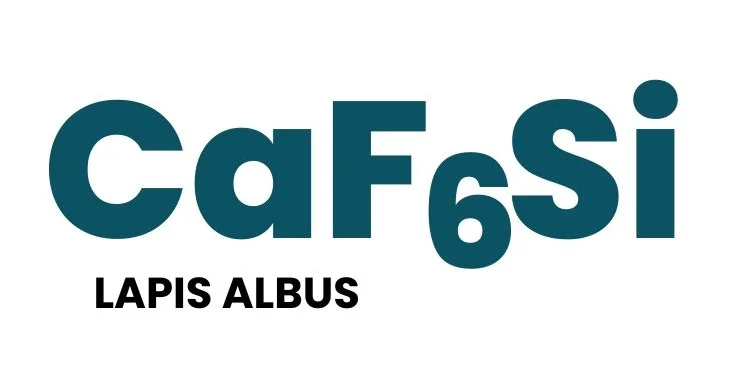Lapis Albus, or Silico-fluoride of Calcium, is a homeopathic remedy known for its remarkable effectiveness in treating glandular affections, including goitre and pre-ulcerative stages of carcinoma.
It is particularly useful for conditions characterized by burning, stinging pains in the breast, stomach, and uterus.
The remedy is also beneficial for fat anaemic babies with a strong craving for iodine and is successful in treating scrofulous affections, except in cases involving malaria.

SOURCE INFORMATION
- Common Name: Silico-fluoride of Calcium
- Scientific Name: Lapis Albus
- Family: Fluorosilicates
Scientific Classification
- Kingdom: Mineral
- Class: Silicate minerals
- Order: Nesosilicates
- Family: Fluorosilicates
- Genus: Lapis
- Species: Albus
Origin
- Lapis Albus is derived from Silico-fluoride of Calcium, a mineral compound.
- It has been utilized in homeopathy for its unique properties in treating various glandular and connective tissue disorders.
Historical Facts
- The remedy has its roots in mineralogy and has been adopted into homeopathy for its specific action on glands and connective tissues.
- Known for its effectiveness in treating goiter and certain stages of carcinoma, it has become a valuable remedy in homeopathic practice.
DRUG PATHOGENESIS
- Lapis Albus acts primarily on the glands and connective tissues, showing a significant effect on conditions involving burning and stinging pains.
- It is particularly effective in pre-ulcerative stages of carcinoma and scrofulous affections, promoting the health of glandular tissues and alleviating associated symptoms.
KEY CHARACTERISTICS
- Glandular Affections: Effective in treating goitre, pre-ulcerative carcinoma, and glandular hardening.
- Burning and Stinging Pains: Notable relief in conditions with burning pains in the breast, stomach, and uterus.
- Elasticity of Glands: Glands affected by Lapis Albus retain a certain elasticity and pliability, contrasting with the stony hardness seen in conditions treated by Calc fluor and Cistus.
DETAILED ORGAN SYMPTOMS
EARS
- Otitis Media Suppurativa: Inflammation and suppuration of the middle ear. Lapis Albus hastens progress when Silica is indicated.
CHEST
- Persistent Pains in Mammary Region: Ongoing pain in the breast area, often associated with glandular hardening.
SKIN
- Scrofulous Abscesses and Sores: Effective in treating scrofulous conditions with abscess formation and sores.
- Enlargement and Induration of Glands: Particularly in the cervical region, where glands become enlarged and hardened.
- Lipoma, Sarcoma, Carcinoma: Useful in treating various tumours and growths.
- Pruritus: Alleviates itching associated with skin conditions.
UTERUS
- Uterine Carcinoma: Beneficial in managing symptoms and slowing the progression of uterine cancer.
- Fibroid Tumours: Relieves intense burning pains and controls haemorrhage associated with fibroid tumours.
APPETITE
- Ravenous Appetite: Particularly in fat anaemic babies who crave iodine.
MODALITIES
- Worse: Symptoms are often associated with glandular and connective tissue issues.
RELATIONSHIP WITH OTHER DRUGS
Compare with:
- Silica: Used in conjunction with Silica for faster progress in otitis media suppurativa.
- Badiaga, Ars iod, Calc iod, Con, Kal iod, Asterias: These remedies share similarities in treating glandular and connective tissue conditions.
DOSE
- Potency: First to sixth potency are commonly used, depending on the severity and nature of the symptoms.
Frequently Asked Questions
What conditions is Lapis Albus used for?
- It is primarily used for glandular affections, goitre, pre-ulcerative carcinoma, scrofulous abscesses, and conditions with burning pains in the breast, stomach, and uterus.
How does Lapis Albus differ from Calc fluor and Cistus?
- Unlike Calc fluor and Cistus, which are associated with stony hardness of glands, Lapis Albus retains a certain elasticity and pliability in the affected glands.
What are the side effects of Lapis Albus?
- Homeopathic remedies are generally considered safe, but it’s always best to use them under the guidance of a qualified homeopathic practitioner.
Can Lapis Albus be used for conditions other than glandular issues?
- Its primary use is for glandular and connective tissue conditions, but it may be used for other related disorders under professional guidance.
What potency of Lapis Albus is most effective?
- The first to sixth potencies are commonly used, depending on the severity and nature of the symptoms.
Glossary of Difficult Words
- Goitre: An enlargement of the thyroid gland.
- Carcinoma: A type of cancer that starts in the skin or the tissues lining other organs.
- Scrofulous: Relating to scrofula, a form of tuberculosis affecting the lymph nodes.
- Haemoptysis: Coughing up blood from the respiratory tract.
- Induration: The process of becoming hard or hardened, especially in reference to tissues.
- Lipoma: A benign tumour composed of fatty tissue.
- Sarcoma: A malignant tumour of connective or other non-epithelial tissue.
- Pruritus: Severe itching of the skin.
- Haemorrhage: An escape of blood from a ruptured blood vessel.
By understanding the detailed properties and uses of Lapis Albus, practitioners can better utilize this remedy for treating various glandular and connective tissue conditions, ensuring effective and safe patient care.
